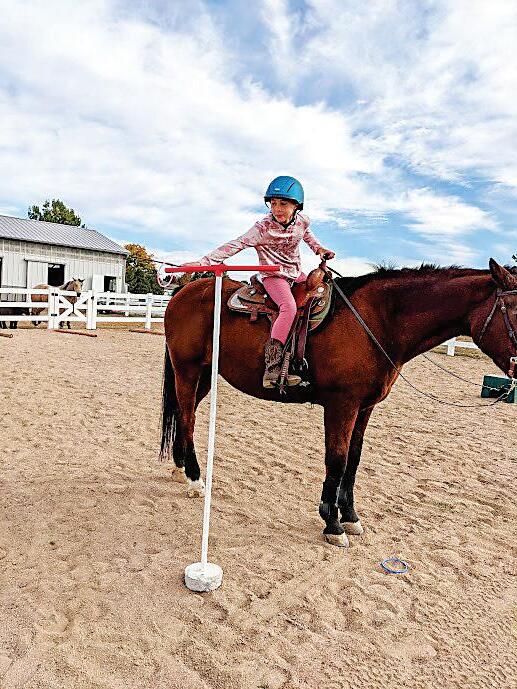
8 minute read
NORTON
mental image top of mind, “Do Not Enter e Comfort Zone.” Whether it’s a physical achievement we are seeking, a business breakthrough, quitting a bad habit, starting a new and positive habit, or maybe setting our sights on breaking the company sales records, once we break free from what has been holding us back, leaving our comfort zone, we need to commit to never going back or settling ever again.
Here is something to watch out for, it’s called the neutral zone. It’s that place where we have decided to break free from our comfort zone but haven’t taken any action yet. Something is still holding us back. Maybe we haven’t fully committed to where it is that we want to go. Maybe we have some head trash that’s getting in our way. Whatever it is, it has us stuck in the neutral zone. How do we get unstuck? We take the rst step in the pursuit of our new goals and dreams. We don’t have to go beyond that, we are not going to go from running a 10K to running a marathon, but we are going to take the rst step and maybe run an extra half mile, and then each day slowly build to our ultimate goal.




individual who does the hard work of soul-searching their thoughts and beliefs about their own mortality. Most of us don’t want to think about that because it’s too sad. But as Benjamin Franklin said, “…in this world nothing can be said to be certain, except death and taxes.” e last wish of the “Five Wishes”
Most end-of-life caregivers will tell you the best gift you can give yourself and your family is the gift of pre-planning. If nances are tight, at a minimum, make some decisions so your family and friends will know your wishes. ere is a wonderful guide called “Five Wishes” that serves as a legal document for end-of-life decisions. Most hospices, funeral homes and cemeteries have some version of the types of questions outlined in the “Five Wishes” document and you can nd it online, too.

Taking that rst step does something psychologically that gets us moving in the right direction. For some of us, we get caught up in all the rest of the steps and it paralyzes us to the point where we do not take any step at all. A comfort zone surrounded by a neutral zone creates a do-nothing zone. And as it has been said before, if we aren’t moving forward, we are more than likely moving backward. Zig Ziglar said it this way, “People who never take step one, can never possibly take step two.”
How about you, are there a rst step that you need to take? Is there a personal or professional goal or dream that you have had on your heart for a while? If so, have you asked yourself what is holding you back? As always, I would love to hear your story at gotonorton@gmail. com, and when we can break free from our comfort zone, leave the neutral zone behind, and commit to never entering that comfort zone again, it really will be a better than good life.
Michael Norton is an author, a personal and professional coach, consultant, trainer, encourager and motivator of individuals and businesses, working with organizations and associations across multiple industries.
Turn To The Colorado Sun For News Across The State
The Colorado Sun is a journalist-owned, award-winning news outlet that strives to cover all of Colorado so that our state — our community — can better understand itself. In this way, The Sun contributes to a more vibrant, informed and whole Colorado.
The Sun, launched in 2018, is committed to fact-based, in-depth and non-partisan journalism. It covers everything from politics and culture to the outdoor industry and education. discusses “What I want my loved ones to know.” is section addresses the emotional realm, as well as physical placement of one’s body after passing. Some key decisions include … How do I want to be remembered? Do I want to be buried or cremated? Do I want to be near relatives? Do I want to be placed somewhere close to my family so it’s convenient for them to visit? Do I want my ashes to be placed at sea or scattered out of an airplane or in a cemetery? Do I want a permanent monument engraved?
Now, The Colorado Sun co-owns this and other Colorado Community Media newspapers as a partner in the Colorado News Conservancy. The Sun is CCM’s partner for statewide news.
For Colorado Sun stories, opinions and more, and to support The Sun’s misssion as a member or subscriber, visit coloradosun. com.
Determining key end-of-life decisions ahead of time will set you free from worry, provide for a smooth transition, and be a gift of peace of mind for your family and friends.
At the Aug. 3, 2023 Seniors’ Council of Douglas County meeting, our host from Seven Stones Cemetery and Botanic Gardens, Becky Holm, will discuss pre-planning, the di erent cemetery options available in Colorado and the beautiful and serene environment at Seven Stones. e meeting is scheduled outdoors from 10-11:30 a.m. at Seven Stones, located at 9635 N. Rampart Range Road in LIttleton. e Seniors’ Council of Douglas County serves to advocate for and engage older adults. Meetings are free and open to the public. Our signature daylong educational event, Vintage and Vibrant, is ursday, Sept. 28 at the Parker Arts, Culture, and Events Center (PACE) in Parker. For upto-date information about Seniors’ Council visit Facebook and our website www.douglas.co.us.
Therapists
BY TAYLER SHAW TSHAW@COLORADOCOMMUNITYMEDIA.COM
When people think of horses, they might associate them with ranch living, horse racing or recreational riding, but horses can be therapeutic, too. erapy takes many forms, from physical to mental. Some people travel to a ranch to work with horses as part of the therapeutic process.
Equine-assisted therapy was something Arvada native Kelsey Petitt discovered while studying occupational therapy at Pima Medical Institute in Denver. Having grown up riding horses, it immediately caught her attention.


“I just, kind of, was like, ‘Oh my gosh, this is the coolest thing ever. I can combine my true passion of horses and really being able to help and assist participants and patients with doing therapy and reaching their functional goals while also having fun with horses and having that relationship,’” Petitt said.
Although she knew immediately that equine-assisted therapy was something she wanted to pursue, she did not do so immediately. Following her schooling and clinical internships, she quickly began working and then had her daughter.
However, in 2021 Petitt, who now lives in Brighton, decided to establish the Brighton-based Prestige erapeutic Equestrian Center, o ering an occupational therapy program that brings the four-legged companions into the practice.
“Now, I’m going on 11 years of being a therapist and so it’s taken me a little bit of time to get back to, really, what I wanted to do,” said Petitt, who also works as an occupational therapy assistant for a company called erapeutic and Rehabilitative Associates.
Her purpose, like many other therapists incorporating horses into their practice, is clear: “Transforming lives through the therapeutic power of horses.”
Bringing horses into occupational therapy
Occupational therapists help people develop skills so that they can perform day-to-day tasks such as bathing, dressing and eating, as well as techniques to aid in memory and concentration, according to the American Occupational erapy Association.
For example, occupational therapists may work on a person’s ne motor skills, such as being able to button a jacket or holding a fork, Petitt said.
ey also work on sensory integration, which she said usually comes up when working with someone who is on the autism spectrum.
Another example of work they do is helping someone with their feeding skills, such as for patients with Parkinson’s disease who experience a lot of tremors. Improving core strength may also be a focus for patients, such as for someone who struggles to put their shirt on due to a lack of strength.
“ ere’s an array of di erent settings that you can get into in the occupational therapy eld, but I think for me, the equine-assisted movement is just something that I’ve always loved,” she said. “Horses are just so therapeutic in general, for anybody.” e term “hippotherapy” refers to how occupational therapy, physical therapy and speech-language pathology professionals use equine movement as a therapy tool, according to the American Hippotherapy Association.
To use hippotherapy in treatment, a person must be a licensed therapist who has completed continuing education in the inclusion of horses and equine movement, per the association. Petitt has gotten her rst level of training with the association, and she plans to continue with her training this fall.
However, Petitt explained that she does not refer to herself as a hippotherapist because hippotherapy is not its own therapy.
“We’re not hippotherapists,” she said. “Hippotherapy is utilizing the horse. All of our treatments are either occupational therapy, speech therapy or physical therapy, and we’re just using the horse as a treatment tool, basically.”
With her clients, she said she is working on all of the same therapy interventions that she would be in a therapy gym or in an outpatient program, but instead she’s now doing it by having her clients get onto a horse and incorporating the horse’s movement into the treatment.
“We work o the horse’s pelvis, so their pelvis is very similar to ours,” she said. ere are di erent planes for the horse in the way that their pelvis moves — the sagittal plane, frontal plane and transverse plane, she said.
“We’re working on that constantly, so when we have our riders on the horse, they’re also working on that. And it’s one of the most multi-dimensional movement(s) that’s rhythmic and repetitive,” she said.
For someone experiencing conditions such as limited mobility, limited core strength, cognitive delays, or sensory processing disorders, “it can really just kind of help bene t and improve all of those elements,” she said of equine-assisted therapy.
According to a study published in the international journal, Physiotherapy eory and Practice, there are “signicant positive e ects” of equine-assisted therapy on exercise tolerance, mobility, interpersonal interactions and quality of life of people with disabilities.
Another study focused on the ef- fects of equine-assisted activities and therapies for individuals on the autism spectrum and concluded that these programs “substantially improve” the social and behavioral functions of people who are on the autism spectrum.

“Communication is pretty key, too … because horses mirror us, so a lot of our participants can learn a lot more speech and communication successfully with the horses, which is really great,” she said.
Petitt has three horses she works with. e horse a client is paired with is dependent on their individual needs, she explained.
“Part of what’s so cool is because we can kind of tailor it to that participant, that patient, and kind of really work on what we need to work on with them,” she said. “ eir postural control, sensory systems, motor planning.”
In a typical therapy gym for occupational therapy, Petitt said there are tools such as a swing, a ball and a mat to use for the session. However, these do not provide the same level of sensory input and rhythmic, consistent movement that equine-assisted therapy can, which she said is great at building overall strength, control and balance.
“We can work in the therapy gym all day but the bene ts and the outcomes that we’re seeing while doing therapy









